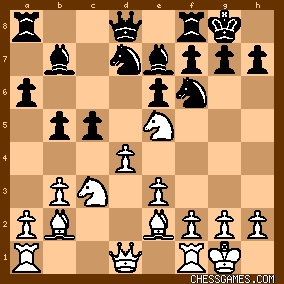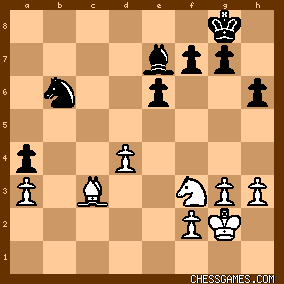| WilhelmThe2nd: The Moscow newspaper 'Izvestia' (Nov. 17th, 1925, page 2) reported that after Rubinstein resigned this game, <"the whole enormous hall, overcrowded with spectators, responded with thunderous applause for this first truly great win in the tournament. Even Rubinstein himself could not resist applauding although, as is well known, there should not be any during play".> Below are Akiba Rubinstein's own annotations to this game from 'Izvestia' (Nov. 21st, 1925, page 3). A few diagrams have been added; the original annotated game included none. [There is a slight discrepancy in the game-score in that this database and Bogoljubow's tournament book both give Black's 48th move as 48. ...Ne3, whereas Rubinstein gives it here as 48. ...Nb6.] <
Queen's Gambit
6th Round 16 November
Rubinstein-Lasker
1. d4 d5
2. c4 c6
3. e3 Nf6
4. Nc3 e6
5. Nf3 Nbd7
6. Bd3 dxc4
7. Bxc4 b5
8. Be2 ...
In this position the more aggressive move 8. Bd3 is also possible. I chose a passive but reliable continuation, since in this game I was striving not so much for a win as for a draw. However, the same law prevails in chess as in life: if you want peace, prepare for war! 8. ... a6
9. O-O Bb7
10. b3 Be7
11. Bb2 O-O
12. Ne5 c5

click for larger viewBlack's development is much more elastic than his opponent's. The White queen does not have a sufficiently good position, and the knight on c3 is much worse than the enemy knight on d7. It must be admitted that White's system of development is not worthy of imitation. 13. Bf3 Qc7
14. Nxd7 Nxd7
15. Ne4 Rad8
16. Rc1 ...
This move looks good, but in reality it is a gross positional error. Black is given the opportunity to isolate the White center pawn, and thus place White in a clearly worse position. I should have played 16. Qc2! 16. ... Qb8
17. Qe2 cxd4!
18. exd4 ...
Capturing with the bishop is impossible because of ...e6-e5 and ...f7-f5.> [WilhelmThe2nd: In the tournament book, Bogoljubow points out that after 18. Bxd4 e5 White can reply 19. Bc5 with equality.]<18. ... Rc8
19. g3 Qa8!
20. Kg2 Rfd8
21. Rxc8 Rxc8
22. Rc1 Rxc1
23. Bxc1 h6
Tempting was ...e6-e5. However, 24. dxe5 Nxe5 25. Nd2 Nxf3 26. Nxf3 would have led to an exchange of pieces and simplification of the position. True, the pin would have been unpleasant for White but he would still have found a sufficient defense. 24. Bb2 Nb6
25. h3 Qc8
26. Qd3 Nd5!

click for larger view27. a3? ...
There was no reason for this move yet. Meanwhile, it completely weakens White's entire position. 27. ... Nb6
28. Kh2 Bd5
29. Kg2 Qc6!
30. Nd2 a5
31. Qc3 ...
White's position is difficult, but not yet hopeless. Comparatively better here was the exchange of bishops in connection with Nf3. After the move in the text, White is already lost. 31. ... Bxf3+
32. Nxf3 ...
Forced. On 32. Qxf3 there follows ...Nd5! and it is impossible to prevent the decisive invasion of the Black queen on c2. 32. ... Qxc3
33. Bxc3 a4!
34. bxa4 bxa4

click for larger view35. Kf1 ...
By means of Bb4 material loss could be avoided, but after the exchange Black still wins owing to the outside passed pawn. 35. ... Bxa3
36. Ke2 Kf8
37. Kd3 Nd5
38. Be1 Bd6
39. Kc4 Ke7
40. Ne5 Bxe5
41. dxe5 Kd7
42. Bd2 h5
43. Bc1 Kc6
44. Ba3 Nb6+!
45. Kd4 Kb5
46. Bf8 Nc4
47. Kc3 g6
48. f4 Nb6
49. Kd3 Nd5
50. Ba3 h4
The endgame is, of course, won for Black. But the skill with which Lasker conducts it is astonishing and worthy of admiration. 51. gxh4 Nxf4+
52. Ke4 Nh5
53. Kf3 Kc4
54. Bb2 Kb3
55. Ba1 a3
56. Kg4 Kc2
57. Kg5 Kd3
0-1
> | 




